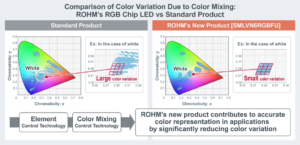
Abstract
Automotive lighting has evolved since the early days when vehicles were equipped with simple incandescent bulbs. The primary function of early lighting systems was to provide illumination and signaling. As automobiles grew in complexity and functionality, so did the need for advanced lighting systems. Today, LEDs dominate the automotive lighting landscape because of their energy efficiency, longer lifespan, and compact form factor.
With newer automotive designs, the demand for custom, energy-efficient, and aesthetically pleasing illumination has driven a growing interest in RGB Chip LEDs. This white paper examines RGB LEDs and LED Driver ICs, shedding light on their functionality, advantages over traditional LEDs, robustness, and automotive applications. It also introduces ROHM’s RGB Chip LED and driver ICs for automotive interior lighting applications.
Basic Structure and Operating Principles
At its core, an RGB LED is a semiconductor diode that emits light when current flows through it. It comprises a PN junction where positive (P-type) and negative (N-type) materials meet. When a voltage is applied, electrons from the N-type material recombine with holes in the P-type material, releasing energy as photons. The energy bandgap of the semiconductor material determines the color of light emitted.
Each RGB Chip LED consists of three individual LED chips—Red, Green, and Blue—in a single package. RGB LEDs are based on the primary color model, and adjusting each chip’s intensity can produce a wide range of colors.
Color Mixing and Production
The specific color emitted by an RGB LED is determined by the relative intensities of the three individual LEDs. Through additive color mixing, virtually any color in the visible spectrum can be created using the three primary colors, such as:
- Red + Green = Yellow
- Red + Blue = Magenta
- Green + Blue = Cyan
- Red + Green + Blue = White
Manipulating the brightness levels (i.e., forward current) of individual LEDs produces millions of color combinations for various lighting scenarios.
Conventional LEDs vs. RGB LEDs
Traditional LEDs used in automotive applications are typically monochromatic: they emit a single color of light based on component materials. Conversely, RGB LEDs combine red, green, and blue emitters into one LED package. By controlling the intensity of each emitter, RGB LEDs produce a wide range of colors, including white light. While standard LEDs are also known to be efficient, RGB polychromatic LEDs further reduce energy consumption by only utilizing the necessary color spectrum for a given application.
RGB Chip LEDs can be integrated into onboard systems to achieve the following:
- Altering colors or intensity based on the weather or time
- Allowing car manufacturers to offer custom lighting options, enhancing personalization and brand differentiation
- Adjusting lighting colors to suit the environment or driving conditions
Challenges of Integrating Newer LED Technology in Automotive Systems
As automotive design evolves, integrating the latest LEDs poses technical challenges. Below is a deeper dive into these challenges to understand the intricacies involved.
Dimming Issues
Dimming is crucial in automotive applications for various reasons, e.g., reducing glare, adjusting to ambient lighting conditions, or enhancing aesthetics. The prevalent technique for regulating the brightness of LEDs is Pulse Width Modulation (PWM) dimming. However, some products may flicker or not dim uniformly when subjected to PWM signals, leading to inconsistent lighting and potential safety hazards.
Voltage and Current Requirements
Another concern for designers and engineers transitioning to new LED technologies is differing power requirements. Depending on component selection, differing power requirements may lead to potential compatibility issues and necessitate modifications to the existing electrical systems.
Heat Dissipation
While newer LEDs are significantly more efficient than their incandescent counterparts, they are not entirely free from producing heat. The localized heat generated at the LED junction needs to be effectively dissipated to ensure longevity. Inadequate heat management can result in reduced LED lifespan, color shift, and, in extreme cases, catastrophic failure.
Space Constraints
The compact and intricate design of modern vehicles poses challenges for engineers integrating LED products. Integrating efficient cooling systems like heat sinks may be impractical with space constraints. Thus, achieving a balance between maintaining the vehicle’s aesthetic and ensuring proper thermal management is critical.
Key Advantages of RGB LEDs for Automotive Illumination
By understanding the benefits of RGB LEDs in automotive lighting applications, engineers and designers can better harness their potential. The following elements present key benefits of RGB LEDs over traditional lighting solutions.
Energy Efficiency
Compared to traditional incandescent and halogen bulbs, RGB LEDs operate on lower voltages and currents. This efficiency results in reduced energy consumption and offers advantages in situations where battery or power resources are constrained.
Long Lifespan
The solid-state nature of RGB LEDs promotes their longevity. Unlike traditional bulbs, which rely on filament heating, RGB LEDs are less prone to failure from mechanical shock and vibration. With lifetimes up to 25 times longer than halogen bulbs, RGB LEDs require fewer replacements for end-users and significant cost savings in manufacturing and procurement for automakers.
Dynamic Color Range
Modulating the intensity of each RGB diode produces an immense variety of colors. This capability allows designers and engineers to differentiate lighting products through unique aesthetic features or functional indications.
Fast Response
The instantaneous response of RGB LEDs ensures critical functions are activated without delay, enhancing driver and pedestrian safety. This feature is useful in applications where fractions of a second can be the difference between safe and unsafe scenarios.
Design Flexibility
The compact design of RGB LEDs allows for versatile integration, enabling sleeker designs and innovative light arrangements in automotive applications.
Thermal Management
Due to their efficient operation, RGB LEDs dissipate significantly less heat. In space-constrained automotive applications, this advantage avoids the need for bulky heat sinks. Moreover, generating minimal heat minimizes the thermal strain on adjacent components. It is important to consider the total power dissipation of an LED when operating at higher ambient temperatures or when driving multiple chips in one package.
Dimming Capabilities
Embedded with microcontrollers, RGB LEDs can be programmed for adaptive lighting solutions, like adjusting the intensity based on ambient light. This feature is beneficial in applications like dashboard illumination, where the brightness needs to be adjusted based on external lighting conditions. With PWM, RGB LEDs achieve dynamic lighting effects, such as gradual illumination or color transitions, enhancing the visual appeal.
Key Considerations for RGB LED/Driver IC Selection
Automotive LEDs must provide reliability, durability, and performance under varied conditions. To achieve this, engineers must consider electrical compatibility, thermal management, and specific automotive needs when selecting RGB Chip LEDs and Driver ICs.
The following considerations support RGB LED selection:
- Luminous Efficacy: Refers to how much illumination LEDs provide for a given power input. Higher luminous efficacy offers more illumination for the same power consumption, saving energy.
- Color Consistency: Refers to consistent color output, critical in applications such as dashboard illumination or ambient lighting. Color consistency also ensures aesthetic appeal and functional uniformity, especially when color changes indicate specific vehicle functions or alerts.
- Lifespan and Degradation: Refers to LEDs’ loss of brightness with prolonged use. Selecting LEDs with minimal luminous degradation and long lifespans ensures longevity.
Key considerations for selecting Driver ICs include the following:
- Dimming Capabilities: Dimming capabilities that are smooth and free from flickering are useful in scenarios like night driving. LED Driver ICs should support these requirements, accommodating PWM or analog dimming protocols.
- Integration with Legacy Systems: Integrating with modern vehicles’ intricate electrical systems is vital for LED Driver ICs, avoiding disruptions or requiring significant modifications.
- Circuit Protection: Protecting circuits, given the vulnerabilities of components to electrical disturbances, requires in-built protective mechanisms for driver ICs. Overcurrent, short-circuit, LED open, and thermal shutdown are vital features that ensure LED and Driver IC reliability.
- Thermal Compatibility: Producing some measure of heat, RGB LEDs and driver ICs should work in tandem. Their combined thermal output must be within specified limits to ensure no overheating occurs, compromising the system’s lifespan or safety.
ROHM’s SMLVN6RGBFU RGB Chip LED
ROHM has introduced the SMLVN6RGBFU, an RGB LED specifically designed for automotive interiors. It utilizes a proprietary element that greatly reduces chromaticity variations (ranks). This ability allows for precise color matching, making it ideal as a light source for automotive interior applications where image color is important, like function and status indicators in instrument clusters, Center Information Displays (CID), and accent lighting in areas such as footwells, door handles, roofs, cup holders, and more. The SMLVN6RGBFU RGB Chip LED delivers vibrant and accurate color representation, ensuring aesthetic appeal and functional utility.
Key Specifications:
- Part Number: BD2808MUV-ME2
- Package: VQFN48MCV070
- LED Configuration: RGB x 8 (24ch)
- Dimming: PWM / DAC
- Per Channel Drive(Max.): 50mA
- Number of Outputs: 24
- Vout(Max.): 20V
- Data Input: SPI
- Operating Temperature Range: -40°C to 105°C
- Package Size: 7×7 (t=1)
- Standard: AEC-Q100 (Automotive Grade)
Figure 1. Color variation due to color mixing: ROHM RGB Chip LED vs. standard product

With the SMLVN6RGBFU RGB LED, ROHM is able to provide calibration support by specifying the adjustment coefficients to target a specific rank, minimizing the color variation. This new RGB chip LED and high-accuracy chromaticity simulation allows precise color matching between multiple LEDs.

Figure 2. Chromaticity simulation in ROHM’s RGB Chip LED
High-Quality Color Representation
The SMLVN6RGBFU reduces color variation by precisely controlling the luminous characteristics of RGB elements, achieved through a vertically integrated production system from the element fabrication stage. The original element color mixing control technology reduces color variations caused by color mixing, resulting in accurate color expression.
Extended Lifespan and Low Maintenance
The design and precise control of the RGB elements of the SMLVN6RGBFU ensure high-quality color representation and contribute to the extended lifespan of the LED. This extended lifespan reduces the need for frequent maintenance and replacements, making it a cost-effective solution for automotive applications.
Enhanced Energy Efficiency
ROHM’s SMLVN6RGBFU RGB Chip LED has achieved high energy efficiency through advanced manufacturing processes. Efficient LED operation results in reduced power consumption in automotive applications, benefiting applications like electric vehicles, where energy usage directly impacts the vehicle’s range.
Ease of Integration and Compatibility
The SMLVN6RGBFU is designed for compatibility with a variety of electronic systems in modern vehicles, such as instrument clusters, CID, car audio/navigation, heater control, and automotive ambient lighting. It is compatible with a constant current or PWM output signal,, simplifying integration and wiring in various vehicle components and systems.
ROHM’s BD2808MUV-M LED Driver IC with 2-line Serial Interface
ROHM’s BD2808MUV-M is an automotive-grade 24-channel constant current sink LED Driver IC optimized for driving ROHM RGB LEDs. It offers a high output voltage capability and offers control for RGB LEDs with a 6-bit Current DAC for each color. Additionally, it integrates an 8-bit PWM control for each channel in a compact VQFN48MCV070 package. The BD2808MUV-M achieves precise control of LED brightness and color, ensuring consistent and reliable performance. With features like PWM dimming, this Driver IC also helps to reduce power consumption.
Key Specifications:
- Topology: Constant Current, Parallel Output LED Driver
- LED Configuration: RGB x 8 (24ch)
- Dimming: PWM / Analog
- Per Channel Drive (Max.): 50mA
- Number of Outputs: 24
- Vout (Max.): 20V
- Data Input: SPI
- Vin Range: 3V to 5.5V
- Operating Temperature Range: -40°C to 105°C
- Package Size: VQFN48 (7x7x1)
- Standard: AEC-Q100 (Automotive Grade)
Features and Benefits:
- Independent PWM Dimming: The IC offers independent PWM control for each of its 24 channels, allowing for precise brightness control of individual LEDs.
- 6-Bit DC Dimming: The BD2808MUV-M can achieve accurate color representation and brightness control with a 6-bit current DAC for RGB.
- PWM Phase Shift Function to Reduce EMI: The IC offers a PWM phase shift function, which is crucial for reducing electromagnetic interference in automotive applications.
- 2-line Serial In/24ch Constant Current Output: This feature ensures low noise operation.
Key Applications
Inaccurate or inconsistent color representation can lead to misinterpretations, which could affect the safety and comfort of vehicle occupants. ROHM’s SMLVN6RGBFU RGB Chip LED utilizes in-house elements with a narrow luminous characteristics range, ensuring minimal chromaticity variation. The colors produced are consistent and match the intended design, enhancing the overall user experience. Below are some key applications.
Cabin Ambient Illumination
The SMLVN6RGBFU offers precise color matching, making it suitable for ambient mood lighting in automotive interiors. It utilizes a proprietary element that significantly minimizes chromaticity variations. In meter clusters, this ensures that icons are illuminated with consistent and accurate colors, enhancing visibility and readability.
Audio and HVAC Controls
The RGB Chip LED’s precise color representation ensures that audio units are backlit uniformly, allowing drivers and passengers to identify and operate controls even in low-light conditions. For HVAC controls, consistent and clear illumination is critical. ROHM’s SMLVN6RGBFU RGB Chip LED provides consistency, ensuring users can easily adjust the vehicle’s temperature settings without visual discrepancies.
Switches and Interface Systems
Switches used frequently, like mirror adjustment buttons, require clear, consistent illumination. The minimized chromaticity variation of ROHM’s RGB Chip LED ensures that these switches are always visible, regardless of the ambient lighting conditions.
RGB Chip LEDs Outshine Traditional Automotive LEDs
With their ability to produce a wide range of colors, RGB Chip LEDs offer myriad advantages in automotive lighting applications, surpassing the capabilities of traditional automotive LEDs and other light sources. Their color variety, compactness, energy efficiency, and enhanced safety features make them a great choice in modern vehicles. In the evolving landscape of automotive lighting, RGB LEDs will remain critical for bridging design and technological innovation. ROHM’s RGB Chip LED and driver ICs are designed to offer accurate color representation and consistent illumination in a wide range of interior lighting applications.
Contact Information and Technical Support
For more information, technical specifications, and support, visit the product page and view the datasheet on ROHM’s website.


More Stories
Towing Services Explained: 6 Key Facts You Need to Know
Environmental Factors That Influence Ceramic Coating Choices
Professional vs. DIY Tinting: What You Should Know